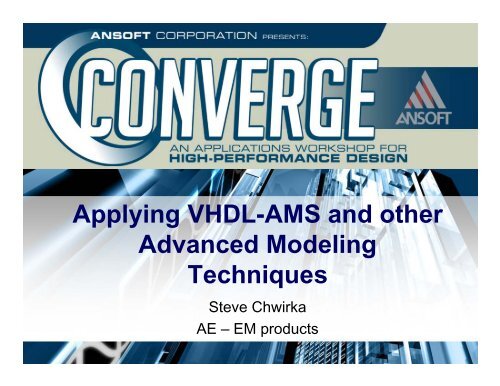Applying VHDL-AMS and Other Advanced Modeling Techniques
Applying VHDL-AMS and Other Advanced Modeling Techniques
Applying VHDL-AMS and Other Advanced Modeling Techniques
Create successful ePaper yourself
Turn your PDF publications into a flip-book with our unique Google optimized e-Paper software.
<strong>Applying</strong> <strong>VHDL</strong>-<strong>AMS</strong> <strong>and</strong> other<br />
<strong>Advanced</strong> <strong>Modeling</strong><br />
<strong>Techniques</strong><br />
Steve Chwirka<br />
AE – EM products
<strong>Applying</strong> <strong>VHDL</strong>-<strong>AMS</strong> <strong>and</strong> other<br />
<strong>Advanced</strong> <strong>Modeling</strong><br />
<strong>Techniques</strong>
What is <strong>VHDL</strong>-<strong>AMS</strong><br />
Very High Speed Integrated Circuit Hardware<br />
Description Language – Analog <strong>and</strong> Mixed-Signal<br />
Description<br />
& simulation<br />
of event-<br />
driven<br />
systems<br />
IEEE 1076<br />
<strong>VHDL</strong><br />
IEEE 1076.1<br />
<strong>VHDL</strong>-<strong>AMS</strong><br />
<strong>VHDL</strong> <strong>AMS</strong><br />
1993 1999<br />
Description &<br />
simulation of<br />
analog <strong>and</strong><br />
mixed signal<br />
circuits <strong>and</strong><br />
systems<br />
<strong>VHDL</strong>-<strong>AMS</strong> is a strict superset of IEEE Std. 1076
Why Use <strong>VHDL</strong>-<strong>AMS</strong><br />
� St<strong>and</strong>ard Format Allows Model Portability<br />
� Different engineering groups within same company<br />
� With Sub-Contractors<br />
� Between different simulators<br />
� Multi-level <strong>Modeling</strong><br />
� Different levels of abstraction of model behavior<br />
� Multi-domain <strong>Modeling</strong><br />
� Electrical, Thermal, Magnetic, Mechanical, etc<br />
� Mixed-signal <strong>Modeling</strong><br />
� Supports analog <strong>and</strong> digital modeling
Basic <strong>VHDL</strong>-<strong>AMS</strong> structure<br />
� Entity<br />
� Interface description of a<br />
subsystem or physical<br />
device<br />
� Specifies input <strong>and</strong> output<br />
ports to the model<br />
� Can specify input<br />
parameters to the model<br />
(A =, B =, C = ..)<br />
input ports<br />
A =<br />
B =<br />
C =<br />
Entity<br />
Architecture 1<br />
Architecture 2<br />
Architecture 3<br />
� Architecture<br />
� Can provide several levels<br />
of model description<br />
� <strong>Modeling</strong> can deal with<br />
both analog (continuous)<br />
<strong>and</strong> digital (discrete)<br />
domains<br />
inout ports<br />
output ports
<strong>VHDL</strong>-<strong>AMS</strong> Simple Example<br />
ENTITY resistor IS<br />
GENERIC (R : REAL := 1.0e+03);<br />
PORT (TERMINAL p,m : ELECTRICAL);<br />
END ENTITY resistor;<br />
ARCHITECTURE behav OF resistor IS<br />
QUANTITY VR ACROSS IR THROUGH p TO m;<br />
BEGIN<br />
VR == IR * R;<br />
END ARCHITECTURE behav;<br />
Voltage (VR)<br />
Current (IR)<br />
V=I*R<br />
p m<br />
resistor<br />
R:=1 kΩ k
<strong>Applying</strong> <strong>VHDL</strong>-<strong>AMS</strong> <strong>Modeling</strong><br />
� This Example will utilize <strong>VHDL</strong>-<strong>AMS</strong> modeling for<br />
the DC/DC power converter design flow.<br />
� Component level (R, L, C, Diode, Switch, opamp, etc)<br />
� Create behavioral linearized average model for designing<br />
the feedback loop, <strong>and</strong> for system level simulations<br />
� Model digital components in the Modulation circuit block<br />
� System level control for - fuse, SSPC, circuit breakers<br />
� In addition to <strong>VHDL</strong>-<strong>AMS</strong> modeling, other<br />
advanced modeling techniques will also be shown<br />
during this design process
Design Process (Converter)<br />
� Define Power Converter Specification<br />
� Input/Output Voltage requirements, Power levels<br />
� Mode of operation (CCM, DCM, Current or Voltage mode)<br />
� Ripple Voltage <strong>and</strong> Current specifications<br />
� Switching Frequency <strong>and</strong> target Efficiency<br />
� Load/line regulation<br />
� Design Power Stage (open loop design)<br />
� Design the feedback loops<br />
� Design the modulation circuit<br />
� Validate closed loop design
Power Stage Design
<strong>VHDL</strong>-<strong>AMS</strong> Behavioral Model
Comparison of Behavioral Model<br />
<strong>and</strong> Switching Circuit (open loop)
Using <strong>VHDL</strong>-<strong>AMS</strong> Behavioral<br />
Model for Feedback Design
Modulation Block Using State<br />
Flow <strong>Modeling</strong><br />
Modulation logic <strong>Modeling</strong><br />
Using State flow Blocks
Closed Loop Switching Circuit<br />
vs. Behavioral <strong>VHDL</strong>-<strong>AMS</strong>
<strong>VHDL</strong>-<strong>AMS</strong> Digital <strong>Modeling</strong>
Digital <strong>VHDL</strong>-<strong>AMS</strong> <strong>Modeling</strong> for<br />
the Modulation Block
Trip Signal<br />
System <strong>Modeling</strong> (SSPC, RPC,<br />
Fuse, Circuit Breakers – control)<br />
Current Flow<br />
Main Relationship<br />
For Trip Characteristic Timing
Simulation Validation of the<br />
<strong>VHDL</strong>-<strong>AMS</strong> Trip Control Model
Summary<br />
ENTITY resistor IS<br />
GENERIC (R : REAL := 1.0e+03);<br />
PORT (TERMINAL p,m : ELECTRICAL);<br />
END ENTITY resistor;<br />
ARCHITECTURE behav OF resistor IS<br />
QUANTITY VR ACROSS IR THROUGH p TO m;<br />
BEGIN<br />
VR == IR * R;<br />
END ARCHITECTURE behav;<br />
Design Process using<br />
SIMPLORER<br />
<strong>VHDL</strong>-<strong>AMS</strong><br />
State Flow<br />
Equation Blocks
Conclusions<br />
� <strong>VHDL</strong>-<strong>AMS</strong> is a very powerful <strong>Modeling</strong> language for not only<br />
mixed signal (Analog/Digital) but also for mixed technology<br />
(Electrical, Mechanical, Thermal, Magnetic, etc.) type designs.<br />
� <strong>VHDL</strong>-<strong>AMS</strong> also allow the users to model based on characteristic<br />
equations of a device <strong>and</strong> not macro-modeling (emulation of<br />
equations using dependent sources, <strong>and</strong> other electrical<br />
components) such as done in other type tools.<br />
� <strong>VHDL</strong>-<strong>AMS</strong> is an IEEE st<strong>and</strong>ard <strong>and</strong> eliminates the problems<br />
associated with other non-st<strong>and</strong>ard or proprietary modeling<br />
languages.<br />
� Don’t have to learn multiple languages<br />
� Models will port to other engineering groups, or sub contractors that<br />
may be using other vendors tools<br />
� Gives Companies a wider selection of vendor tools without the loss<br />
of IP

















